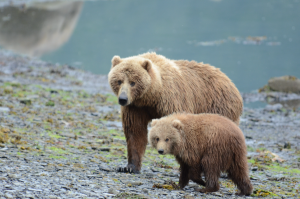
How are Atlantic and Pacific salmon related to each other, and how do their lifecycles differ?
As their names suggest, Atlantic salmon are originally from the Atlantic Ocean, while Pacific Salmon are from the Pacific Ocean. Atlantic and Pacific salmon belong to the family Salmonidae, but Pacific salmon belong to the genus Oncorhynchus while Atlantic salmon (Salmo salar) are the largest members of the genus Salmo. Atlantic salmon are more closely related to certain species of trout, such as brown trout (Salmo trutta), than they are to Pacific salmon.
There is only one species of Atlantic salmon, and members of this species are silvery with large, black spots on their gill covers and back. The five species of Pacific salmon are pink salmon, also known as humpies; chum salmon, also known as dog salmon; red salmon, also known as sockeyes; silver salmon, also known as coho; and king salmon, also known as chinook. Pacific salmon, like Atlantic salmon, are sleek and silvery in their marine phase, but once they enter fresh water, they go through significant physical changes, and each species has distinctive markings. The photos below show a sockeye salmon in the marine phase and in the spawning phase when the salmon returns to freshwater.
The lifecycles of natural populations of Atlantic and Pacific salmon are similar. Atlantic salmon spend one to four years in the ocean before returning to spawn in the freshwater stream where they were born. One big difference, though, is Atlantic salmon don’t always die after they spawn. Pacific salmon are semelparous, meaning they die after they spawn. Atlantic salmon are iteroparous which means they might recover, return to the sea, and repeat the migration and spawning pattern. Spawning takes a huge physiological toll on a salmon, though, and most Atlantic salmon do not survive to spawn a second or third time.
Are Atlantic or Pacific salmon healthier to eat?
Controversy swirls over the health benefits of eating Atlantic and Pacific salmon. This debate has nothing to do with wild Atlantic salmon, though. Most salmon sold in the U.S. are farmed Atlantic salmon. Salmon sold as “wild” salmon are Pacific salmon. Sadly, most wild Atlantic salmon stocks were wiped out or severely depleted years ago by over-fishing, but in a few places, these wild stocks are recovering.
The question then becomes is farmed or wild salmon healthier to eat, or does it matter?
What are the health differences between eating a wild or farmed salmon?
Salmon is good for you. Both wild and farmed salmon are high in Omega-3 fatty acids, a fat with many health benefits. Farmed salmon, though, also have other fats which are not as good for humans. A half-pound filet of wild salmon has 281 calories, while a half-pound fillet of farmed salmon contains 412 calories. Farmed salmon is loaded with twice as much fat as wild salmon and three times more saturated fat. Wild salmon packs more calcium, iron, potassium, and zinc and less sodium than farmed salmon. Depending on the farm, farmed salmon might have higher levels of contaminants than wild salmon, but biologists believe farmed salmon is safe to eat.
Most experts agree if you have a choice, eat wild salmon, but farmed salmon is better than no salmon, and farmed salmon is more readily available, can be found year-round, and usually costs less.
I think the biggest difference is taste. Wild Pacific salmon has a rich, robust flavor, while farmed salmon often tastes bland.
Could farmed fish threaten native species?
One of the biggest concerns biologists have about farmed salmon is that the salmon will escape their pens and become an invasive species. How these farmed salmon might affect wild salmon populations, no one knows, but biologists fear farmed salmon might spread parasites and diseases. Atlantic and Pacific salmon can’t interbreed because they belong to different genera, but these salmon have similar lifecycles. Would escaped farmed fish compete with native fish for habitat and food?
In 2017, 300,000 Atlantic salmon escaped from a farm in the San Juan Islands in Puget Sound, Washington, and alarmed Alaska Fish and Game biologists sent out an alert to all anglers to be on the lookout for invasive Atlantic salmon.
What is the difference?
Atlantic salmon are large trout, but Pacific and Atlantic salmon look similar and have comparable life cycles. Atlantic salmon don’t necessarily die after they spawn, but Pacific salmon always die after they return to a freshwater stream to spawn.
Atlantic salmon are rare in nature because over-fishing has decimated their stocks. Atlantic salmon fillets you find in the grocery store come from farmed salmon. If you see a Pacific salmon fillet in a store or restaurant in the U.S., it almost certainly originated from a wild salmon.
Both wild and farmed salmon are high in Omega-3 fatty acids, but farmed salmon contains other fats not good for you. Farmed salmon fillets appear paler than wild salmon, and they are not as flavorful as wild Pacific salmon.

Robin Barefield is the author of three Alaska wilderness mystery novels, Big Game, Murder Over Kodiak, and The Fisherman’s Daughter. To download a free copy of one of her novels, watch her webinar about how she became an author and why she writes Alaska wilderness mysteries. If you like audiobooks, check out her audiobook version of Murder Over Kodiak. Also, sign up below to subscribe to her free, monthly newsletter on true murder and mystery in Alaska.







